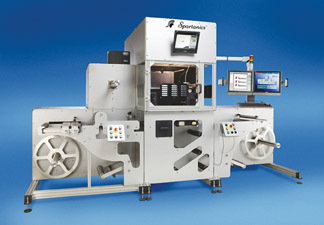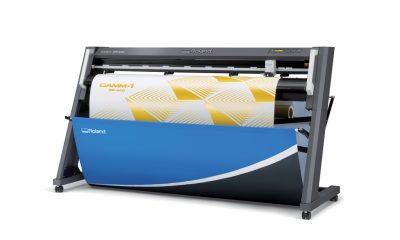Graphics Printing
Published
24 years agoon
Successful screen printing involves doing the simple things well. Cleaning a screen during production is one such procedure that’s easy to master, yet many printers do it very badly. And the result is excessive waste, poor print quality, and reduced stencil life.
Successful screen printing involves doing the simple things well. Cleaning a screen during production is one such procedure that’s easy to master, yet many printers do it very badly. And the result is excessive waste, poor print quality, and reduced stencil life.
The normal scenario begins when an image area becomes contaminated with dirt or dried ink. The printer sees the resulting print flaw and stops the press. The screen frame is lifted and the printer assaults the underside of the stencil with a solvent-soaked abrasive cloth. The squealing of mesh can be heard across the shop–it’s stencil language for "Stop rubbing so hard! You’re tearing my emulsion." Occasionally a fatal "crack" is heard, followed by the sound of a ripping screen and the cry of a press operator: "Curse that #@*~! weak mesh again!"
A truly expert printer rarely rubs the print side of a stencil because he knows that print definition requires a sharp emulsion shoulder at all image edges. Abrasion removes that necessary shoulder, and further abrasion scores channels in the emulsion. Continued abuse actually removes the emulsion, leaving only bare mesh. Any further abrasion at this point results in that familiar shriek from both the screen and the press operator.
When printing fine- or high-line process-color images, the film of emulsion below the threads can be as little as 5-6 microns thick and the mesh itself may have a thread diameter of just 30 microns. While this combination of thin mesh and emulsion is remarkably tough, it will not withstand the violent physical abuse wrought upon it by unthinking printers. So the real key to avoid abusive cleaning is to prevent contamination of the stencil in the first place.
The greatest cause of contamination is poor ink-management practices that lead to dried ink in the mesh. With solvent- and water-based inks, the problem may result from improperly mixed ink, thinner, and/or retarder. Always use the recommended amounts of additives to suit the application. Also, maintain the condition of the ink during the run by frequently adding pre-mixed ink in small amounts. And when using UV-curable ink, take steps to shield the printing screen from all UV light sources–including sunlight shining through adjacent windows.
Another ink-management problem involves using an improper floodstroke. An incorrectly set floodstroke on an automatic press or inadequate floodstroke on a manual press will result in irregular ink distribution, leading to under-filled mesh openings that dry out quickly.
A final cause of drying is an incorrectly set or worn squeegee. Fine-detail images printed with a high mesh count require a squeegee with a sharp edge set at an angle of approximately 75°; from horizontal. As the squeegee wears or distorts through normal use and solvent absorption, image definition will deteriorate around the edges, indicating that ink may not be properly flowing through the mesh. If the problem is allowed to continue, ink may dry in the mesh. To prevent these problems, flip the squeegee periodically to extend edge life, or replace it completely before image deterioration begins.
The next mesh-saving procedure involves controlling dirt–either in the ink or on the substrate. Substrates can become dirty due to static electricity that attracts airborne contaminants or from poor storage conditions. But you can avoid this problem with good housekeeping and process control. Additionally, tools such as static-elimination and substrate-cleaning systems can prevent dust and dirt on substrates from getting onto the mesh, were it can contaminate the ink and clog stencil openings.
But how do you remove contamination from a stencil if it does occur? If you’re printing with a flatbed graphics press, stop the machine after the print stroke. Next, feed in a sheet of absorbent paper, and make sure that the screen’s off-contact height is correctly set so that the screen makes contact with the absorbent material during cleaning.
With the screen in its printing position, wash the squeegee side (top) of the stencil with a non-abrasive cloth or tissue that you have wetted with the appropriate screen-washing product. Gently wipe the surface. This will flush contaminants through the mesh onto the absorbent material below. If necessary, repeat the procedure with another absorbent sheet. Some dirt particles on the top surface may be too big to wash through the mesh, but they will lift off with the cleaning cloth instead. When you are satisfied that the contaminants are removed, dry the stencil with a hair dryer set to "cool."
When using a bottle-printing press or similar press for three-dimensional parts, the same cleansing principles apply, with one exception: Instead of placing absorbent sheets on the press bed, attach them to one of the parts to be printed. This will hold the absorbent material in the correct position below the screen as you clean the stencil from above.
Cleaning a cylinder press presents a different problem. Its configuration means that it is impossible to wash contaminants through to an absorbent substrate as you would with a conventional graphics press. Fortunately, due to high printing speeds, ink does not have as much opportunity to dry in the mesh. When it does, you can preserve the life of the stencil by first stopping the press after the print stroke. Next, using a nonabrasive cloth or tissue, apply screen wash or thinner to the top of the stencil in the image areas. Try not to leave excess cleaner on the top of the stencil. Your goal is to "charge" the mesh openings with solvent to loosen any contaminants. Then run six waste sheets through the print cycle. This should flush out the offending particles.
Occasionally, you may have to remove a contaminant from the underside of the stencil. In such situations, use a tissue or cloth and gently brush the offending debris away–do not rub it.
These preventive steps can help you achieve minimal rejects and a stencil that will last and last. Make these procedures part of your standard production routine.
Phone-printing problems
One of the greatest growth areas for both pad printing and screen printing in the past year has been mobile phones. In the UK, the demand for these phones has nearly quadrupled during the last twelve months. The trend is expected to continue on both sides of the Atlantic.
Mobile phones present a new opportunity for printers, as well as a unique set of issues: The phones may include customized covers printed with well-known cartoon and film characters printed under license. (My word, aren’t those licenses expensive!) With the licenses come exact specifications concerning image and color requirements. To make matters more difficult, these images then have to be printed on the contoured surface of the phones.
Screen printing frequently is combined with injection molding to produce some mobile phones, but many are molded first, then sprayed with a coating, pad printed, and then finished with a protective clearcoat. This combination of coating and printing poses two problems: One relating to the printability of the sprayed surface, the other involving compatibility between the printed images and the final protective coating.
The initial spray coat often creates varying surface finishes that are not apparent until you attempt to pad print over them. During the print stroke, the ink may not transfer off the pad. The cause of this problem is that the surface energy of the sprayed coating is lower than the surface tension of the ink film. But the problem can be overcome by using an ink with a lower surface tension. It requires some experimentation, but we’ve found that changing the ink is the simplest solution.
Another ink-transfer problem related to the initial spray coating is the dusty overspray residue left on the surface of the phone. When such residue is present, a single pad-printing cycle often does not produce the desired image. The solution is to use a double print cycle, where the first print cycle removes the residue and the second provides a complete print on the clean surface.
The next concern is the printed design’s affect on the final lacquer coating. The problem is that the image area tends to repel the lacquer during the application process. This happens only over the printed image and is caused by leftover silicone from the pad.
When we experienced this problem, we changed to an older pad and the problem became less obvious. But it was impossible to fully eradicate the silicone residue because most pads are a combination of silicone rubber and silicone oil. So we switched to special lower-oil pads. To overcome the lacquer-application problem completely, we eventually had to add quantities of wetting agent to the lacquer.
Pad printing on mobile phones or other objects that have additional coatings is a challenging proposition. But by understanding all the variables, you can overcome almost any obstacle.

Subscribe

Magazine
Get the most important news
and business ideas from Screenprinting Magazine.
Most Popular
-

 Art, Ad, or Alchemy1 month ago
Art, Ad, or Alchemy1 month agoF&I Printing Is Everywhere!
-

 Case Studies1 month ago
Case Studies1 month agoHigh-Density Inks Help Specialty Printing Take Center Stage
-

 Andy MacDougall1 month ago
Andy MacDougall1 month agoFunctional and Industrial Printing is EVERYWHERE!
-

 Columns2 weeks ago
Columns2 weeks ago8 Marketing Mistakes Not to Make When Promoting Your Screen Printing Services Online
-

 Editor's Note2 weeks ago
Editor's Note2 weeks agoLivin’ the High Life
-

 Thomas Trimingham2 months ago
Thomas Trimingham2 months ago“Magic” Marketing for Screen Printing Shops
-

 Marshall Atkinson2 weeks ago
Marshall Atkinson2 weeks agoHow to Create a Winning Culture in Your Screen-Printing Business
-

 News & Trends1 month ago
News & Trends1 month agoWhat Are ZALPHAS and How Can You Serve Them in Your Print Business?






